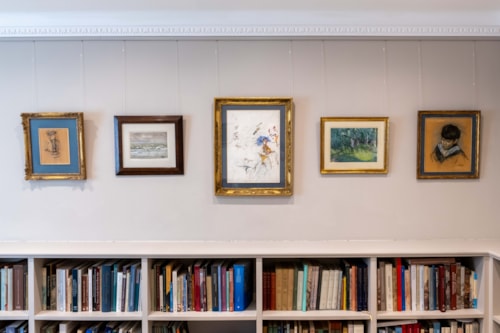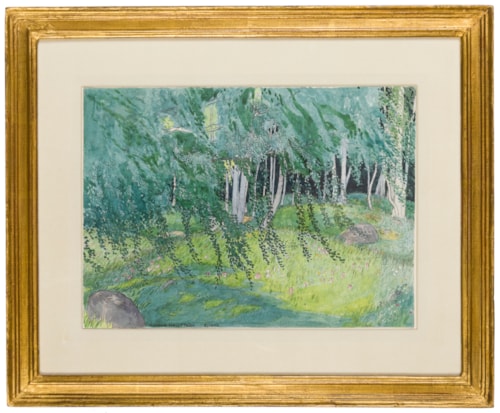Gunnar August HALLSTRÖM
(Stockholm 1875 - Adelsö 1943)
Trees at Björkö
Pen and black ink and watercolour.
Signed and inscribed GUNNAR HALLSTRÖM. BJÖRKÖ at the lower left centre.
249 x 341 mm. (9 3/4 x 13 1/2 in.)
Signed and inscribed GUNNAR HALLSTRÖM. BJÖRKÖ at the lower left centre.
249 x 341 mm. (9 3/4 x 13 1/2 in.)
This fine watercolour was drawn on the island of Björkö (Swedish for ‘birch island’), where Gunnar Hallström lived for much of his life. Björkö was the site of several ancient Bronze and Iron Age remains, as well as the early Viking-era trading settlement of Birka, established around 750 AD, and Hallström campaigned to have the island preserved from exploitation and the proposed construction of summer homes. Together with his archaeologist brother Gustaf, he was able to have parts of Björkö purchased by the State between 1912 and 1914, later added to by the Swedish Academy of Sciences, so as to preserve the natural landscape for posterity. The care of the island came under the purview of the Swedish National Heritage Board (as it remains today), and Birka, along with the site of Hovgården on the neighbouring island of Adelsö, became a World Heritage site in 1993.
Hallström served as a supervisor on Björkö until the 1930s and spent much of the latter part of his life working on a written account of the ancient culture of the island, which remained unpublished at his death and only appeared in 1997, in partial form, as Björkö saga: människor och liv på en Mälarö (Björkö Saga: People and Life on a Mälar Island).
Hallström served as a supervisor on Björkö until the 1930s and spent much of the latter part of his life working on a written account of the ancient culture of the island, which remained unpublished at his death and only appeared in 1997, in partial form, as Björkö saga: människor och liv på en Mälarö (Björkö Saga: People and Life on a Mälar Island).
The eldest of four children, Gunnar August Hallström was born in Södermalm, the southern district of Stockholm, and studied at the Royal Swedish Academy of Fine Arts between 1893 and 1897, winning several prizes. Early in his career he worked as an illustrator, providing images for such works as Verner von Heidenstam’s Ett folk, published in 1899, and Johan Ludvig Runeberg’s long poem Älgskyttarne. En dikt i nio sånger, which appeared the following year. Hallström completed his training with a scholarship to study in Paris for a year in 1906-1907, which was followed by travels in Europe and Russia. As a painter, Hallström produced landscapes and portraits, as well as subjects from folklore and Norse history. He also produced mural decorations and cartoons for tapestries, as well as set and costume designs for a ballet. Between 1910 and 1912 he served as director of the Valand art school in Gothenberg, and also designed the poster for a Scandinavian Art Exhibition which travelled to five American cities between 1912 and 1913.
In 1912 Hallström and his family settled on the small island of Björkö on Lake Mälaren, some thirty kilometres west of Stockholm, where the artist became involved in attempts to preserve the island’s landscape and its archeological remains. Hallström began painting works inspired by a romantic and historical vision of traditional life on Björkö, as well as landscapes inspired by the scenery of the island. His relative isolation on Björkö meant that he remained largely apart from Stockholm and much of the Swedish art world at large. He sat on the board of the Swedish Society for Nature Conservation and was a member of the Society of Sciences, History and Antiquities. A memorial exhibition of Hallström’s work was held at Royal Academy of Fine Arts in 1946, three years after his death. Two of his four children also became artists. Works by the artist are today in the museums of Stockholm, Gothenberg and Malmö, as well as in the Musée du Grand Siècle in Saint-Cloud.
In 1912 Hallström and his family settled on the small island of Björkö on Lake Mälaren, some thirty kilometres west of Stockholm, where the artist became involved in attempts to preserve the island’s landscape and its archeological remains. Hallström began painting works inspired by a romantic and historical vision of traditional life on Björkö, as well as landscapes inspired by the scenery of the island. His relative isolation on Björkö meant that he remained largely apart from Stockholm and much of the Swedish art world at large. He sat on the board of the Swedish Society for Nature Conservation and was a member of the Society of Sciences, History and Antiquities. A memorial exhibition of Hallström’s work was held at Royal Academy of Fine Arts in 1946, three years after his death. Two of his four children also became artists. Works by the artist are today in the museums of Stockholm, Gothenberg and Malmö, as well as in the Musée du Grand Siècle in Saint-Cloud.







